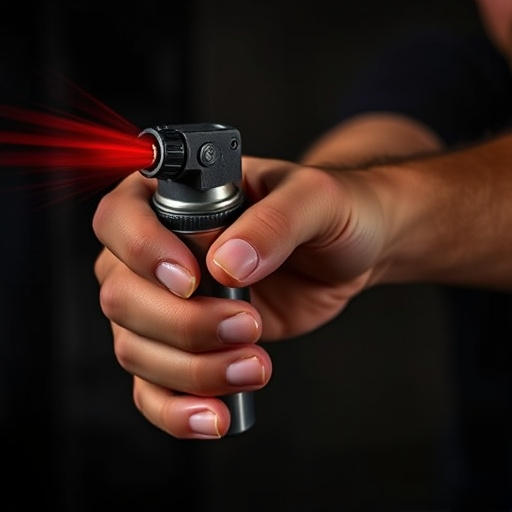Non-lethal pepper spray defense, utilizing capsaicin, temporarily incapacitates attackers without causing harm. It creates intense discomfort, reducing mobility and combat effectiveness, providing users crucial escape or help-seeking time. Strategic deployment focuses on blind spots (eyes, respiratory system), safe distance (3-15 feet), precise aim, and regular practice. Legal implications and responsible use within jurisdiction are essential, understanding pepper spray's limits and capabilities, adhering to manufacturer guidelines, and training in de-escalation techniques.
“Uncover the power of non-lethal pepper spray as a vital tool in personal defense. This comprehensive guide explores the science behind its composition, how it disrupts an attacker’s senses, and strategic deployment techniques for maximum effectiveness. We delve into legal considerations, ensuring users understand their rights while emphasizing responsible use. Learn to empower yourself with this potent yet non-lethal defense mechanism, providing peace of mind in potentially dangerous situations.”
- Understanding Non-Lethal Pepper Spray: Its Composition and Effectiveness
- Strategic Deployment: Maximizing the Impact of Pepper Spray for Self-Defense
- Legal Considerations and Responsible Use: Ensuring Your Rights and Safety
Understanding Non-Lethal Pepper Spray: Its Composition and Effectiveness
Non-lethal pepper spray is a powerful tool for personal defense, designed to incapacitate an attacker temporarily without causing permanent harm. Its composition typically includes capsaicin, the active ingredient found in chili peppers, mixed with other chemical agents and a carrier liquid. When deployed, the spray creates a burning sensation in the eyes, nose, and throat, leading to temporary blindness, coughing, and difficulty breathing. This disruption significantly reduces an attacker’s mobility and combat effectiveness, providing the user with crucial time to escape or seek help.
The effectiveness of non-lethal pepper spray defense lies in its ability to create a psychological and physical barrier against assault. The immediate and intense reaction it elicits can deter potential attackers, allowing users to maintain their safety and security. Furthermore, unlike lethal force, pepper spray is selective; it’s meant to subdue and control rather than to kill, making it an attractive option for self-defense in various situations, from personal encounters to crowd control scenarios.
Strategic Deployment: Maximizing the Impact of Pepper Spray for Self-Defense
Strategic deployment is key to maximizing the impact of non-lethal pepper spray for self-defense. It’s not just about having the spray, but using it intelligently. Offenders often have blind spots or weak points, like eyes and respiratory system, that pepper spray can exploit. Aiming directly at these areas, even from a distance, can cause severe disorientation and temporary incapacitation.
Knowing your surroundings and potential threats is crucial. Pepper spray is most effective in close to medium range (3-15 feet), so be aware of the space you’re in and maintain a safe distance from aggressors. A swift, precise burst of pepper spray delivered at close range can give you precious time to escape or call for help. Practice your aim and deployment techniques regularly to ensure your non-lethal pepper spray defense is ready when you need it most.
Legal Considerations and Responsible Use: Ensuring Your Rights and Safety
When considering a non-lethal pepper spray defense, it’s crucial to understand the legal implications and responsible use. Each jurisdiction has specific laws governing the possession, use, and application of pepper spray, which can range from self-defense to law enforcement purposes. It’s essential to check local legislation to ensure compliance and avoid any potential legal repercussions.
Responsible use involves understanding the limits and capabilities of pepper spray. While it’s an effective deterrent and non-lethal force option, it should only be deployed in situations where alternative methods are not feasible. Targeting specific areas like the eyes and face, as per manufacturer guidelines, ensures safety and minimizes harm to others. Proper training and knowledge of de-escalation techniques further emphasize responsible use, ensuring your rights and safety during any confrontation.
Maximizing your safety through strategic deployment of non-lethal pepper spray is a powerful tool for personal defense. By understanding its composition, effectiveness, and legal considerations, you can make informed decisions to protect yourself while adhering to responsible use guidelines. Armed with this knowledge, you’ll be better equipped to navigate potentially dangerous situations, ensuring your rights and safety in any environment.
